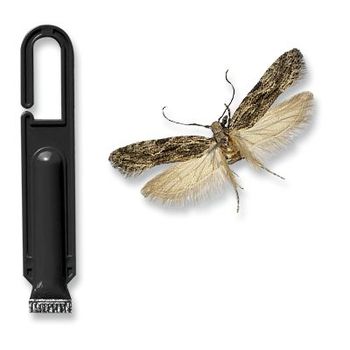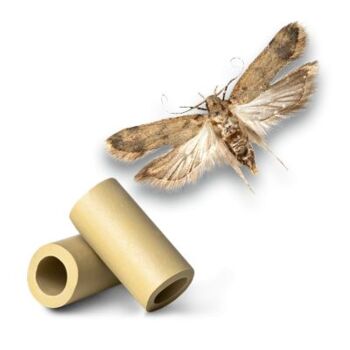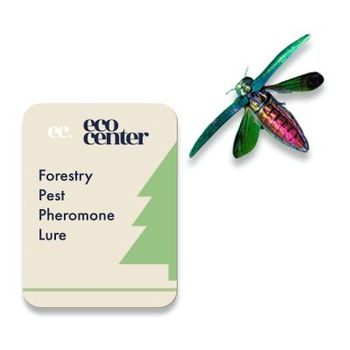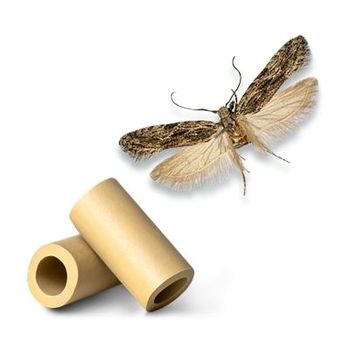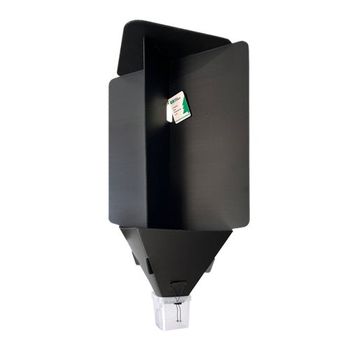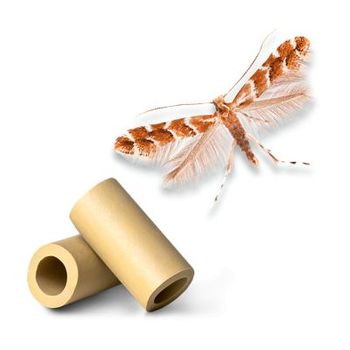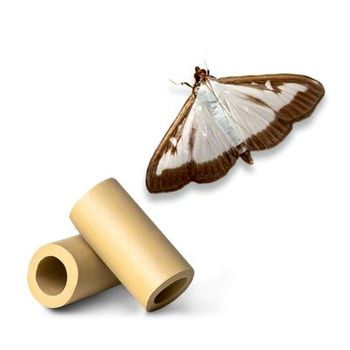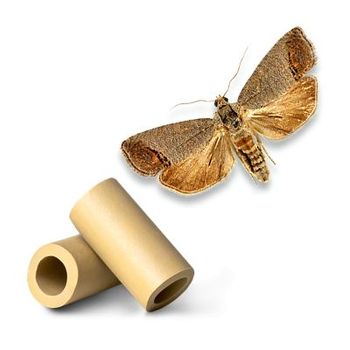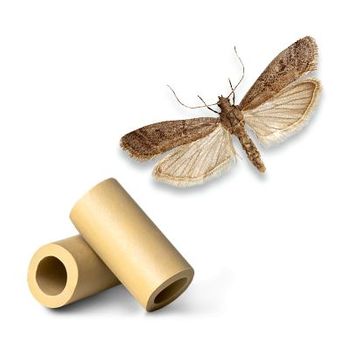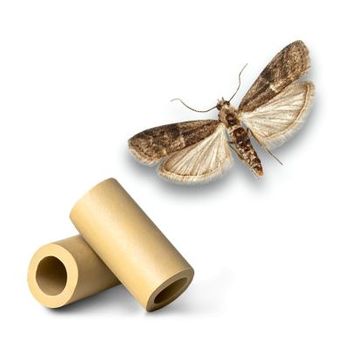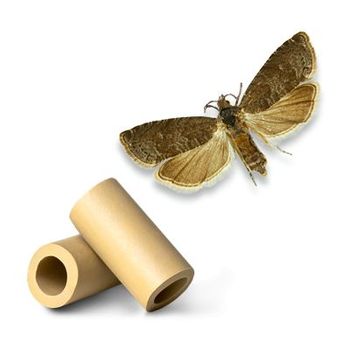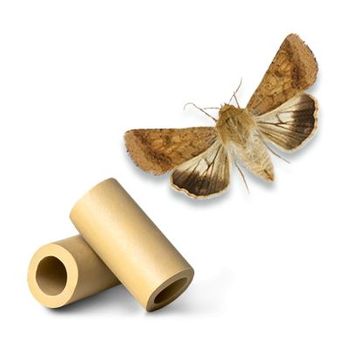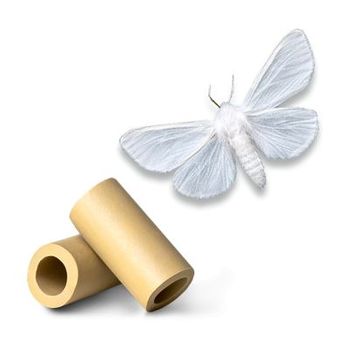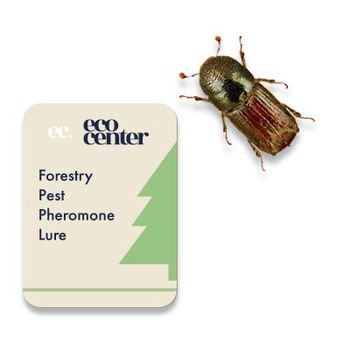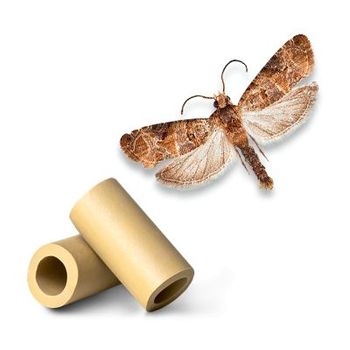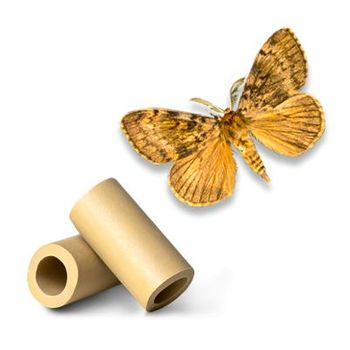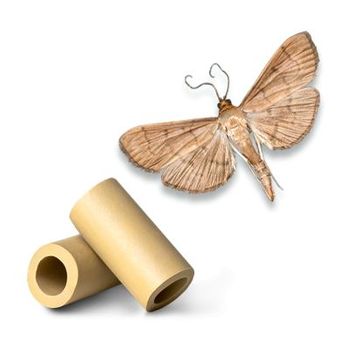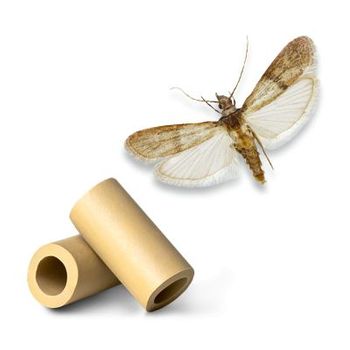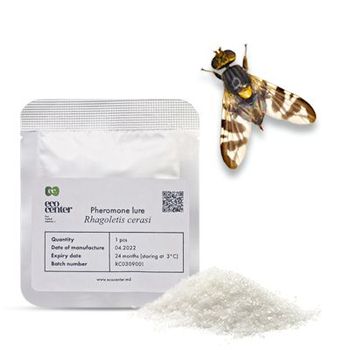Delta Plastic trap Yellow (with insert)
Delta Plastic trap Yellow is a great monitoring trap that allows to make a quick estimation of Lepidoptera pests population in orchards, greenhouses, vineyards etc. This trap is easy to assemble and use, and is both durable and cost-efficient.
A target insect lure must be used within the trap, to attract the pests into the trap to land on the adhesive surface of the sticky insert, that is provided together with the trap.
Anarsia Protect®
Anarsia Protect® plant protection product against (Anarsia lineatella) peach twig borer. Mating disruption is a tool that involves the overstimulation of Anarsia lineatella male pests with deployment of pheromones via Anarsia Protect® dispensers, causing males to follow “false pheromone trails”, therefore interfering with mate finding behaviour.
Pectinophora gossypiella lures
Pectinophora gossypiella lure is a component of an insect trapping device, that uses pheromones to lure pink bollworm into a trap.
The lure, in the form of the rubber dispenser, that contains female pheromone of pink bollworm, must be placed in a Delta Plastic Trap to be fully functional (traps can be bought separately or in kits with lures).
Using such pheromone lures is an economic, environmentally sound approach to either monitor or trap these pests.
The lures in the traps must be replaced every 4-6 weeks to keep attraction rates high.
Shelf life - up to 2 years (optimum conditions).
Agrilus planipennis lures
Agrilus planipennis lure is a component of an insect trapping device, that uses pheromones to lure emerald ash borer into a trap.
The lure, in the form of the cellulose dispenser, that contains pheromone of emerald ash borer, must be placed in a EC Forest trap to be fully functional (traps can be bought separately or in kits with lures).
Using such pheromone lures is an economic, environmentally sound approach to either monitor or trap these pests.
The lures in the traps must be replaced every 8-10 weeks to keep attraction rates high.
Shelf life - up to 2 years (optimum conditions).
Anarsia lineatella lures
Anarsia lineatella lure is a component of an insect trapping device, that uses pheromones to lure peach twig borer into a trap.
The lure, in the form of the rubber dispenser, that contains female pheromone of peach twig borer, must be placed in a Delta Plastic Trap to be fully functional (traps can be bought separately or in kits with lures).
Using such pheromone lures is an economic, environmentally sound approach to either monitor or trap these pests.
The lures in the traps must be replaced every 4-6 weeks to keep attraction rates high.
Shelf life - up to 2 years (optimum conditions).
EC Forest Trap Anoplophora glabripennis Kit
The EC Forest Trap Anoplophora glabripennis Kit provides a cost-effective and environmentally friendly solution for trapping and monitoring asian long-horned beetle. By using this kit, users can accurately assess the risk of pest infestation and determine the need for further pest management actions.
The kit includes the EC Forest Trap and an Anoplophora glabripennis lure, offering a comprehensive approach to effective pest control.
Both traps and lures can also be purchased separately. Crafted from durable recycled plastic, the EC Forest trap is easy to assemble and designed for user convenience, making it a practical choice for any user.
The lures in the traps must be replaced every 8-10 weeks to keep attraction rates high.
Cameraria ohridella lures
Cameraria ohridella lure is a component of an insect trapping device, that uses pheromones to lure horse-chestnut leaf miner into a trap.
The lure, in the form of the rubber dispenser, that contains female pheromone of horse-chestnut leaf miner, must be placed in a Delta Plastic Trap to be fully functional (traps can be bought separately or in kits with lures).
Using such pheromone lures is an economic, environmentally sound approach to either monitor or trap these pests.
The lures in the traps must be replaced every 4-6 weeks to keep attraction rates high.
Shelf life - up to 2 years (optimum conditions).
Cydalima perspectalis lures
Cydalima perspectalis lure is a component of an insect trapping device, that uses pheromones to lure box tree moth into a trap.
The lure, in the form of the rubber dispenser, that contains female pheromone of box tree moth, must be placed in a Delta Plastic Trap to be fully functional (traps can be bought separately or in kits with lures).
Using such pheromone lures is an economic, environmentally sound approach to either monitor or trap these pests.
The lures in the traps must be replaced every 4-6 weeks to keep attraction rates high.
Shelf life - up to 2 years (optimum conditions).
Cydia pomonella lures
Cydia pomonella lure is a component of an insect trapping device, that uses pheromones to lure codling moth into a trap.
The lure, in the form of the rubber dispenser, that contains female pheromone of codling moth, must be placed in a Delta Plastic Trap to be fully functional (traps can be bought separately or in kits with lures).
Using such pheromone lures is an economic, environmentally sound approach to either monitor or trap these pests.
The lures in the traps must be replaced every 4-6 weeks to keep attraction rates high.
Shelf life - up to 2 years (optimum conditions).
Ephestia elutella lures
Ephestia elutella lure is a component of an insect trapping device, that uses pheromones to lure cacao moth/tobacco moth into a trap.
The lure, in the form of the rubber dispenser, that contains female pheromone of cacao moth/tobacco moth, must be placed in a Delta Plastic Trap to be fully functional (traps can be bought separately or in kits with lures).
Using such pheromone lures is an economic, environmentally sound approach to either monitor or trap these pests.
The lures in the traps must be replaced every 4-6 weeks to keep attraction rates high.
Shelf life - up to 2 years (optimum conditions).
Euzophera bigella lures
Euzophera bigella lure is a component of an insect trapping device, that uses pheromones to lure quince moth into a trap.
The lure, in the form of the rubber dispenser, that contains female pheromone of quince moth, must be placed in a Delta Plastic Trap to be fully functional (traps can be bought separately or in kits with lures).
Using such pheromone lures is an economic, environmentally sound approach to either monitor or trap these pests.
The lures in the traps must be replaced every 4-6 weeks to keep attraction rates high.
Shelf life - up to 2 years (optimum conditions).
Grapholita funebrana/ Grapholita molesta lures
Grapholita funebrana/ Grapholita molesta lure is a component of an insect trapping device, that uses pheromones to lure plum fruit moth/ oriental fruit moth into a trap.
The lure, in the form of the rubber dispenser, that contains female pheromone of plum fruit moth/ oriental fruit moth, must be placed in a Delta Plastic Trap to be fully functional (traps can be bought separately or in kits with lures).
Using such pheromone lures is an economic, environmentally sound approach to either monitor or trap these pests.
The lures in the traps must be replaced every 4-6 weeks to keep attraction rates high.
Shelf life - up to 2 years (optimum conditions).
Helicoverpa armigera lures
Helicoverpa armigera lure is a component of an insect trapping device, that uses pheromones to lure cotton bollworm into a trap.
The lure, in the form of the rubber dispenser, that contains female pheromone of cotton bollworm, must be placed in a Delta Plastic Trap to be fully functional (traps can be bought separately or in kits with lures).
Using such pheromone lures is an economic, environmentally sound approach to either monitor or trap these pests.
The lures in the traps must be replaced every 4-6 weeks to keep attraction rates high.
Shelf life - up to 2 years (optimum conditions).
Hyphantria cunea lures
Hyphantria cunea lure is a component of an insect trapping device, that uses pheromones to lure fall webworm into a trap.
The lure, in the form of the rubber dispenser, that contains female pheromone of fall webworm, must be placed in a Delta Plastic Trap to be fully functional (traps can be bought separately or in kits with lures).
Using such pheromone lures is an economic, environmentally sound approach to either monitor or trap these pests.
The lures in the traps must be replaced every 6-7 weeks to keep attraction rates high.
Shelf life - up to 2 years (optimum conditions).
Ips Spp. lures
Ips spp. lure is a component of an insect trapping device, that uses pheromones to lure bark beetles into a trap.
The lure, in the form of the cellulose dispenser, that contains pheromone of bark beetles, must be placed in a EC Forest trap to be fully functional (traps can be bought separately or in kits with lures).
Using such pheromone lures is an economic, environmentally sound approach to either monitor or trap these pests.
The lures in the traps must be replaced every 8-10 weeks to keep attraction rates high.
Shelf life - up to 2 years (optimum conditions).
Lobesia botrana lures
Lobesia botrana lure is a component of an insect trapping device, that uses pheromones to lure European grapevine moth into a trap.
The lure, in the form of the rubber dispenser, that contains female pheromone of European grapevine moth, must be placed in a Delta Plastic Trap to be fully functional (traps can be bought separately or in kits with lures).
Using such pheromone lures is an economic, environmentally sound approach to either monitor or trap these pests.
The lures in the traps must be replaced every 4-6 weeks to keep attraction rates high.
Shelf life - up to 2 years (optimum conditions).
Lymantria dispar lures
Lymantria dispar lure is a component of an insect trapping device, that uses pheromones to lure spongy moth into a trap.
The lure, in the form of the rubber dispenser, that contains female pheromone of spongy moth, must be placed in a Delta Plastic Trap to be fully functional (traps can be bought separately or in kits with lures).
Using such pheromone lures is an economic, environmentally sound approach to either monitor or trap these pests.
The lures in the traps must be replaced every 4-6 weeks to keep attraction rates high.
Shelf life - up to 2 years (optimum conditions).
Monochamus spp. lures
Monochamus spp. lure is a component of an insect trapping device, that uses pheromones to lure sawyer beetles into a trap.
The lure, in the form of the cellulose dispenser, that contains pheromone of sawyer beetles, must be placed in a EC Forest trap to be fully functional (traps can be bought separately or in kits with lures).
Using such pheromone lures is an economic, environmentally sound approach to either monitor or trap these pests.
The lures in the traps must be replaced every 8-10 weeks to keep attraction rates high.
Shelf life - up to 2 years (optimum conditions).
Ostrinia nubilalis lures
Ostrinia nubilalis lure is a component of an insect trapping device, that uses pheromones to lure European corn borer into a trap.
The lure, in the form of the rubber dispenser, that contains female pheromone of European corn borer, must be placed in a Delta Plastic Trap to be fully functional (traps can be bought separately or in kits with lures).
Using such pheromone lures is an economic, environmentally sound approach to either monitor or trap these pests.
The lures in the traps must be replaced every 4-6 weeks to keep attraction rates high.
Shelf life - up to 2 years (optimum conditions).
Plodia interpunctella lures
Plodia interpunctella lure is a component of an insect trapping device, that uses pheromones to lure Indian meal moth into a trap.
The lure, in the form of the rubber dispenser, that contains female pheromone of Indian meal moth, must be placed in a Delta Plastic Trap to be fully functional (traps can be bought separately or in kits with lures).
Using such pheromone lures is an economic, environmentally sound approach to either monitor or trap these pests.
The lures in the traps must be replaced every 4-6 weeks to keep attraction rates high.
Shelf life - up to 2 years (optimum conditions).
Rhagoletis cerasi lure
Rhagoletis cerasi lure is a component of an insect trapping device, that uses to lure cherry fruit fly into a trap.
The attractant, in the form of the PE sachet, that contains attractant for cherry fruit fly, must be placed in a EC Fruit fly Trap to be fully functional (traps can be bought separately or in kits with lures).
Using such lure is an economic, environmentally sound approach to either monitor or trap these pests.
The lure in the traps must be replaced every 4-6 weeks to keep attraction rates high.
Shelf life - up to 2 years (optimum conditions).

